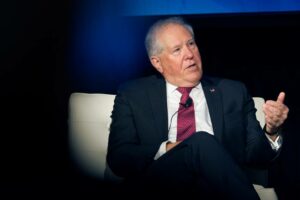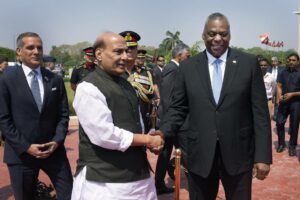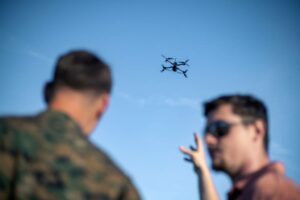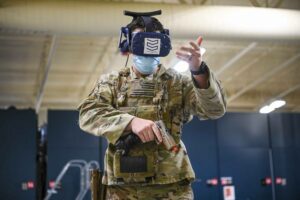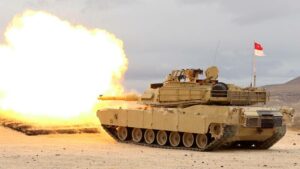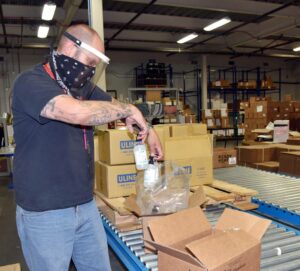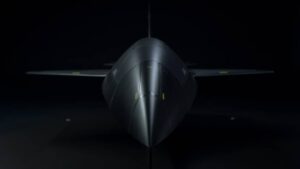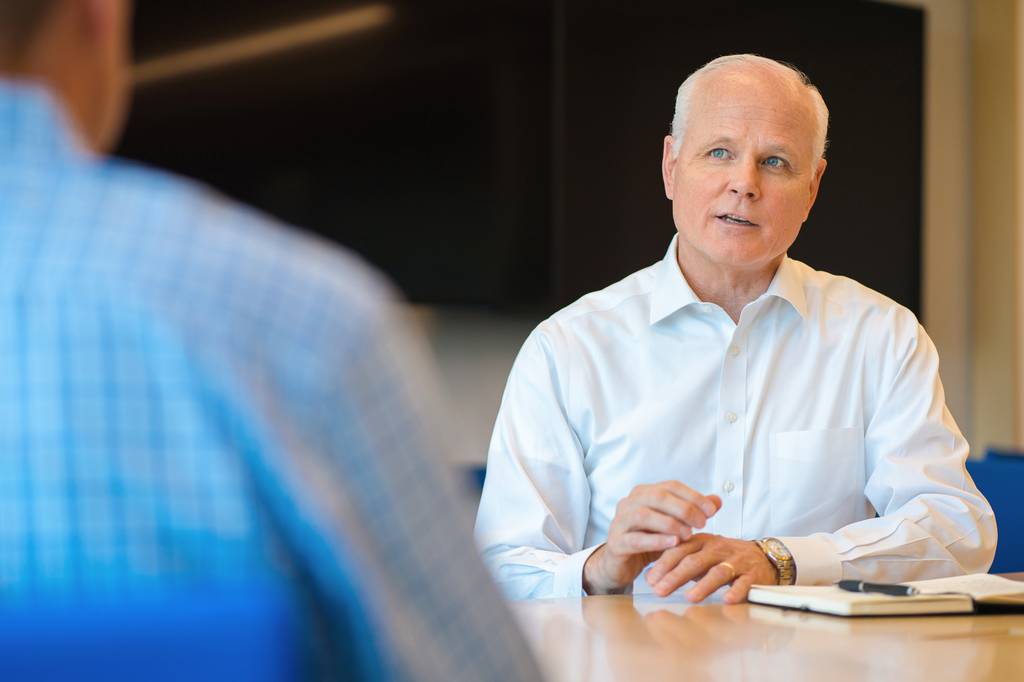
RESTON, Va. — As Leidos approaches its 10th year as an independent company, the defense technology firm’s chief executive is using the occasion to sharpen the organization’s “North Star” vision and identify duplication and inefficiency within its portfolio.
The Virginia-based company occupies the No. 16 spot in the 2023 edition of the Defense News Top 100 list, which ranks firms based on annual defense revenue. In the last eight years, the company has grown to 47,000 from 23,000 employees and increased its annual revenue to nearly $15 billion from $5 billion.
CEO Tom Bell, who joined Leidos in May, told investors during a quarterly earnings call that while the company is healthy, there’s room for “strategic sharpening.”
“As we crystallize this new North Star, we will use it to guide all our strategic decisions,” he said Aug. 1. “We will take steps to simplify our organizational structure to promote operational excellence, allow for faster decision making and more tightly align our business across our key technology differentiators.”
In an Aug. 2 interview with C4ISRNET, Bell discussed his plan to help refine the company’s vision, hone in on technology focus areas and work with the Pentagon to field capabilities on faster timelines.
This interview has been edited for length and clarity.
Can you describe the process of casting a new vision for Leidos?
I inherited a company that is inherently in good shape. There’s no crisis here. The company has been well run and is in a good place in really important markets for our customers. So, we have the luxury to be able to look at it and talk about how we tune it, not how we fundamentally address a problem.
The North Star conversation is simply a time for us, as we reflect on the beginning of our second decade as an independent company, to say, “OK, who do we want to be in the next 5 to 10 years? What is the guiding principle for where we’re taking this company?”
We have mission statements and vision statements and those things have served us well. But it strikes me as we are on the cusp of our 10th anniversary and looking at our second decade, it’s the perfect time to say, what’s the North Star for 2023 and beyond?
The North Star isn’t going to be that suddenly we’re going to go 90 degrees left or 90 degrees right. The North Star is going to be more of a direction of travel on the trajectory we’re already on, but crisping it up, making it clear for our people.
As you enter into this process, what areas of the company do you think might need some refining?
We have grown tremendously in the last seven, eight years. But with all that growth, you end up — especially with COVID — doing acquisitions and bolting on capabilities. You make them work, but nobody suggested that they were perfect.
What I have found is the organization has capabilities replicated in different places, which doesn’t necessarily mean you’re as efficient and as effective as possible — efficient in making sure you’re pulling through technology for all customers and effective at making sure you’re giving all the customers best-in-class capabilities for whatever problem they’re trying to solve.
As I’ve done my diagnostics of the business, there’s pockets of the same thing replicated in different value streams. And this refining and this tuning that I talked about is just aligning that, like a jigsaw puzzle or a Rubik’s Cube. Let’s put all the red pieces together and the blue pieces together and the green pieces together.
What’s an example of an area where there’s duplication?
Let’s just start at the core of what we do — digital modernization. That’s a core capability that Leidos has, yet we’re doing digital modernization in all the current value streams. Is there a better way to organize around that technology? Maybe the answer is no. Maybe we don’t want to core that up. But if you don’t core it up, then how are you going to make sure you’re pulling through the technologies so that all those various customers have the benefit of the best-in-class Leidos capabilities?
We do that through a mechanism we call technology accelerators. That’s kind of our horizontal cut-through of technologies. And maybe that works. Maybe we keep that. But also, maybe we relook at that and think about how do we do it better.
You’ve talked before about Leidos’ “golden bolts,” or technology specialties that distinguish you from other companies. What are examples of some of those?
Cyber is a big golden bolt for us. Software engineering is a big golden bolt for us. Materials technology that allows for hypersonics is a big golden bolt for us. AI is all over the news these days, but we’ve been pioneering AI for the better part of 20 years in Leidos. So we think AI is a golden bolt for us. EW is one, signals processing is one.
These are the kinds of things that we need to ensure we stay world class in because these are the things that are going to enable us to continue to serve our customers in a different way. I don’t have a full catalog of them yet, but they are the precious things that link the company together.
The golden bolts are also part of a conversation about what are we good at today? What do we want to continue to invest in to accelerate away from our competition in? What are the technologies that are going to differentiate us in 2028? What are the technologies that are going to differentiate us in 2033?
When do you expect Leidos will have this refined vision and focus in place?
I’m challenging the team that we want to be up and running with the tuned organization, with a clearer articulation of the North Star, and a very good idea of our golden bolts by the beginning of next year. So, we start 2024 fresh.
Now, notice what I didn’t say. I didn’t say we’re going to have the roadmap to 2028 done by then. That’s harder work. That’s longer-term work. These are interim steps to get us match fit to prosecute 2024. And then we’ll be working on the next iteration of our strategic plan for Leidos and where we’re taking this company.
Hypersonics has been a growth area for Leidos in recent years. How do you think about growth in that portfolio in the future?
We’re on both sides of the hypersonic conversation. How do we ensure that our country has hypersonic capabilities, and how do we ensure our country can defend against hypersonic capabilities? That means we believe hypersonic technology is a very important aspect of our customer’s vexing problems that we think we have a differentiated way of helping solve. We’re very thrilled to be there.
Is that a growth engine? Yes, but it’s not going to pay the bills for the next 10 years. It’s just an important vexing problem that we think we can solve with differentiated technology and differentiated thinking at pace.
Courtney Albon is C4ISRNET’s space and emerging technology reporter. She has covered the U.S. military since 2012, with a focus on the Air Force and Space Force. She has reported on some of the Defense Department’s most significant acquisition, budget and policy challenges.
- SEO Powered Content & PR Distribution. Get Amplified Today.
- PlatoData.Network Vertical Generative Ai. Empower Yourself. Access Here.
- PlatoAiStream. Web3 Intelligence. Knowledge Amplified. Access Here.
- PlatoESG. Automotive / EVs, Carbon, CleanTech, Energy, Environment, Solar, Waste Management. Access Here.
- BlockOffsets. Modernizing Environmental Offset Ownership. Access Here.
- Source: https://www.defensenews.com/home/2023/08/08/leidos-refining-focus-crafting-north-star-vision-ceo-tom-bell-says/
- :has
- :is
- :not
- :where
- $UP
- 000
- 1
- 10
- 100
- 10th
- 16
- 20
- 20 years
- 2012
- 2023
- 2024
- 2028
- 23
- 70
- 90
- a
- Able
- About
- accelerate
- accelerators
- acquisition
- across
- address
- against
- AI
- AIR
- Air Force
- align
- aligning
- All
- allow
- allows
- already
- also
- an
- and
- Anniversary
- annual
- ANNUAL REVENUE
- answer
- approaches
- ARE
- AREA
- areas
- around
- AS
- aspect
- At
- Aug
- away
- based
- BE
- because
- been
- before
- Beginning
- believe
- Bell
- benefit
- Better
- Beyond
- Big
- Billion
- Bills
- Blue
- Bolt
- both
- Both Sides
- budget
- business
- but
- by
- call
- CAN
- capabilities
- capability
- catalog
- ceo
- challenges
- challenging
- chief
- Chief Executive
- clarity
- class
- clear
- clearer
- Companies
- company
- Company’s
- competition
- continue
- Conversation
- Core
- country
- covered
- Covid
- crisis
- Current
- Cusp
- Customers
- Days
- decade
- decision
- Decision Making
- decisions
- Defense
- describe
- different
- differentiate
- differentiated
- digital
- direction
- discussed
- distinguish
- do
- Doesn’t
- doing
- done
- Dont
- during
- Earnings
- earnings call
- edition
- Effective
- efficient
- emerging
- Emerging Technology
- employees
- enable
- end
- Engine
- ensure
- Enter
- especially
- example
- examples
- Excellence
- executive
- expect
- faster
- field
- firms
- fit
- Focus
- For
- Force
- found
- fresh
- from
- full
- fundamentally
- future
- get
- Giving
- Go
- going
- Golden
- good
- Green
- grown
- Growth
- growth area
- guide
- harder
- Have
- he
- healthy
- help
- helping
- here
- his
- Horizontal
- How
- HTTPS
- i
- idea
- identify
- if
- images
- important
- important aspect
- in
- increased
- independent
- inherently
- Interview
- into
- Invest
- Investors
- IT
- iteration
- ITS
- jigsaw
- joined
- jpg
- just
- Keep
- Key
- Kind
- Last
- left
- Length
- like
- LINK
- Look
- looking
- Luxury
- make
- Making
- Markets
- Match
- materials
- maybe
- me
- mean
- means
- mechanism
- might
- Military
- Mission
- modernization
- more
- most
- my
- nearly
- necessarily
- Need
- New
- news
- next
- no
- North
- Notice..
- occasion
- occupies
- of
- on
- ONE
- operational
- or
- organization
- organizational
- Other
- our
- over
- Pace
- part
- Pay
- pentagon
- People
- perfect
- pieces
- Pioneering
- Place
- Places
- plan
- plato
- Plato Data Intelligence
- PlatoData
- pockets
- policy
- portfolio
- possible
- Precious
- principle
- Problem
- problems
- process
- processing
- promote
- pulling
- put
- puzzle
- ranks
- really
- recent
- Red
- refine
- refined
- refining
- reflect
- replicated
- Reported
- reporter
- revenue
- right
- roadmap
- Room
- Run
- running
- s
- Said
- same
- say
- says
- Second
- serve
- seven
- Shape
- sharpening
- she
- Sides
- significant
- simplify
- simply
- since
- So
- SOLVE
- some
- Space
- Space Force
- Specialties
- Spot
- Star
- start
- statements
- stay
- Steps
- Strategic
- streams
- Strikes
- structure
- sure
- Take
- taking
- Talk
- team
- Technologies
- Technology
- that
- The
- The Future
- Them
- then
- There.
- These
- they
- thing
- things
- think
- Thinking
- this
- those
- thrilled
- Through
- tightly
- time
- timelines
- to
- today
- together
- tom
- top
- trajectory
- travel
- tremendously
- u.s.
- us
- use
- using
- value
- various
- very
- vision
- want
- Way..
- we
- WELL
- were
- What
- What is
- whatever
- which
- while
- WHO
- will
- with
- within
- Work
- working
- works
- world
- year
- years
- yes
- yet
- you
- zephyrnet

